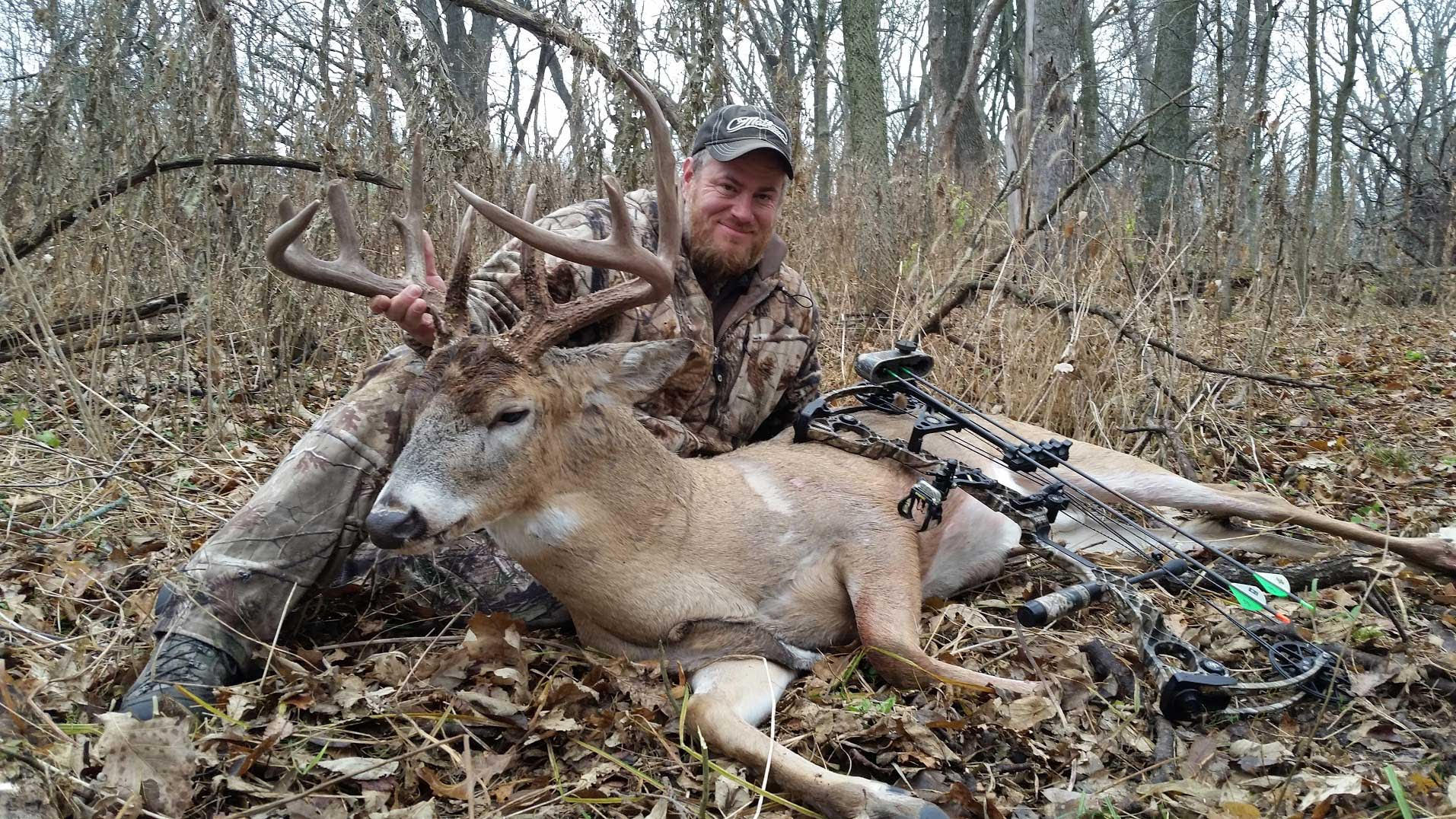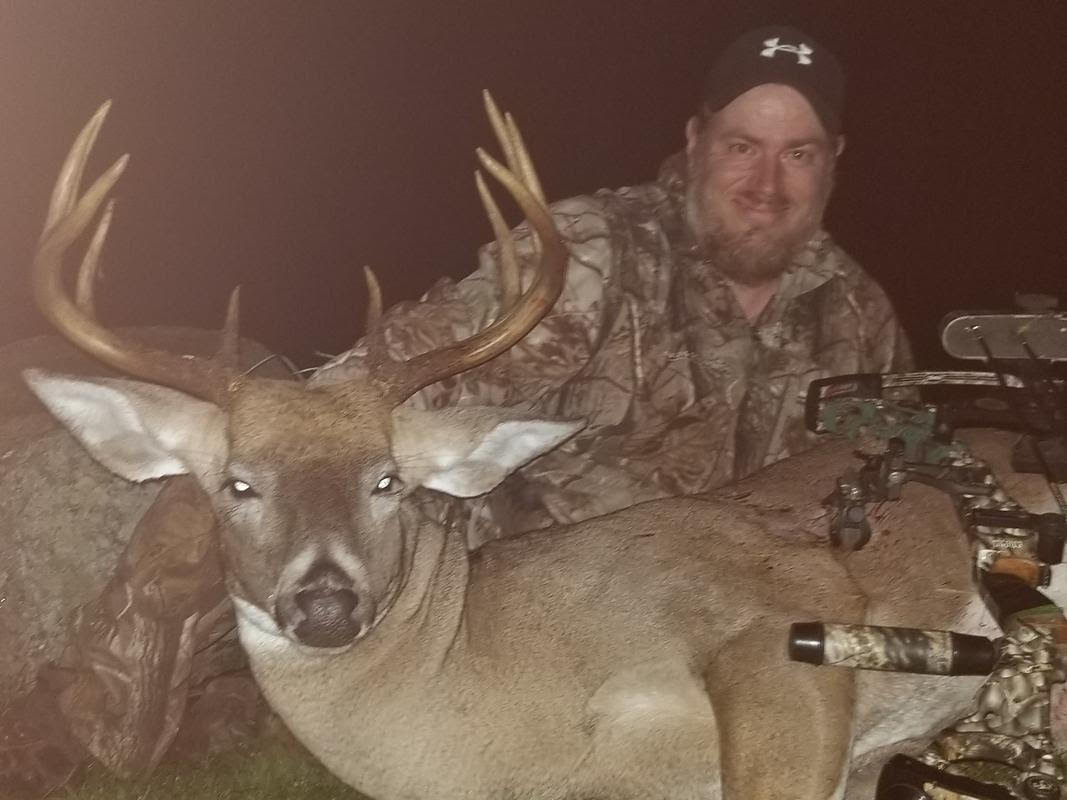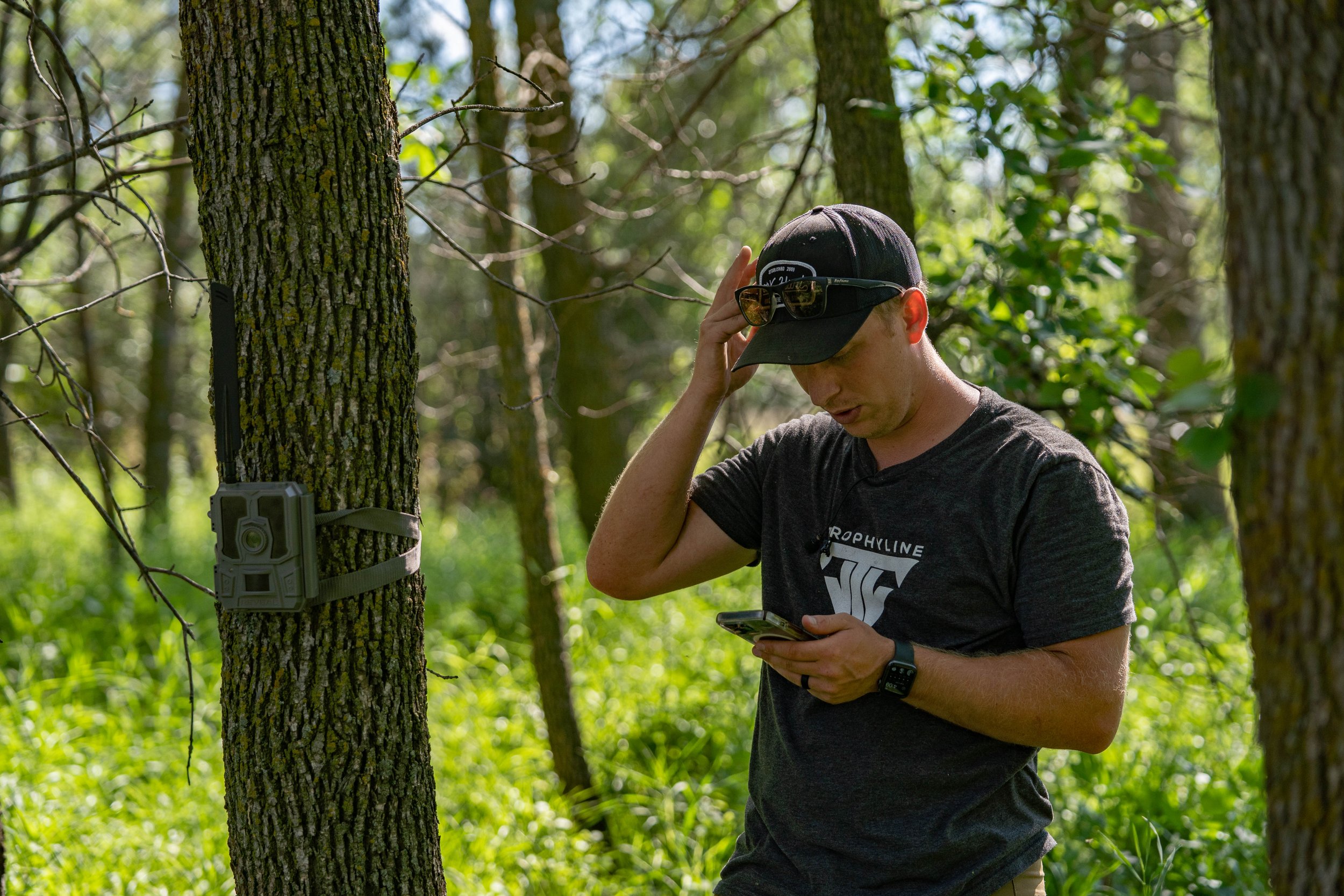By Scott Spitzley
Editor’s note: If you’ve missed the first two Q&A’s with this series, you can read the first one by clicking HERE and the second one HERE. This has been a great series, containing a wealth of whitetail knowledge. - Alex
Next, with The Hunting Beast Q&A series, we have Ben Bruno, AKA “Mainebowhunter” on the Hunting Beast site from Maine. As you read this interview, you will quickly learn from reading his first answer that he is very humble and full of faith. He is respected by many on the forum because of how much effort and passion he puts into chasing whitetails, which leads to being able to put mature bucks down consistently on both private and public lands across multiple states. His success in the whitetail woods is most definitely earned. Enjoy.
Q. How and when did your hunting journey begin?
Ben: Let me start with this. God has given me the gift of hunting. He has given/allowed me to have legs to walk, arms to shoot, eyes to see and ears to hear. Without these gifts and blessings, none of this would even be possible. Whenever I start feeling like I am great, God has a way of humbling me and reminding me, these are gifts and I am blessed. At any point, all of this could be taken away from me. I have a career that I have been blessed with, a wonderful wife who is a gift from above and 2 beautiful children. Owning my own business allows a lot of free time to spend time in the woods, my favorite place to be is in the middle of God's creation.
I would say I am relatively a newbie when it comes to serious hunting. I started hunting at the age of 10 and killed my first deer when I was 17 with my dad. I was proud as a peacock with this buck. At this point, I knew nothing about archery, nothing about the midwest and virtually nothing about deer hunting.
I killed another good buck when I was 19, then I left for college. No hunting for 4yrs. Came back home, graduated from college and started to hunt. Grabbed a bow in 1997, no idea what I was doing. A friend of mine gave me his old bow. It had no peep sight, no kisser button, and no release. I did not shoot well. This process really started to show me there had to be more to this game. My dad got me into hunting, but really did not have a lot of hunting skills.
In 1999 I believe is when I purchased my first real bow. AND, around that same time is when I purchased my first bunch of scent-lok with all the sprays and stuff that went with it. I got dressed at my truck, had a special bag I put everything in. And I started to scout. I really had no idea what I was doing. But I knew there were guys around that were killing deer, seeing deer and some were killing big deer. HOW? My dad’s idea of hunting was to walk around the woods all November, barely see a deer, let alone shoot one. The season could never get over soon enough.
In 2004, I ended up linking up with a guy, kind of my hunting mentor. He was the guy who introduced me to the midwest. I got involved with hunting and the filming end. 2003/2004 was my introduction to sitting in a tree with a video camera, filming. Again, I was loving it, thinking man "I have killed a couple of bucks, now I am on a film crew." We had sponsors, ended up with a new bow, double bull blind, broadheads, lighted nocks, all the good stuff. I killed some deer on video, killed a bear and I had plenty of misses. I really thought maybe this could turn into something. With the hunting craze, it was short-lived.
Late fall 2010, winter 2011 is when I really decided it was time to start really chasing bigger bucks harder in Maine. Up until this point, it just seemed like a waste of time. I would kill some does and a small buck to eat, focus my attention for a big buck on a state with bigger deer. I started purchasing some trail cams and I started to really hardcore scout.
Q. What type of terrain(s) do you hunt? (Hill country, marshland, farm country, etc)
Ben: I hunt mostly woods, some hills, some marsh, some swamp. Maine is 89% timber. Alder thickets, edges are much more of a factor in most of what I hunt because I spend the majority of my time on flat ground. Hayfields, vegetables here and there. But no crops. It's mostly mast crop — apples, acorns, beechnuts, and grass.
When I travel to hunt, its mostly midwest farm country. I have hunted Kansas, Nebraska, Illinois, Indiana, Maryland, Massachusetts, and Ohio. The last 10 yrs we have been in Kansas and Nebraska.
Q. What is the most important thing you put into your style that helped you have success?
Ben: I love being in the woods. In addition to that, the willingness to learn and not be afraid to try new tactics. Forums, videos, podcast, the list goes on. Great tools, but time in the woods and deer are the best teachers. There really is no easy way to success. I just had to keep pushing and scouting and failing until it started to make a bit more sense.
My “tactics” include a litany of a lot of things. And those tactics are always changing and evolving. But they are my tactics. Sometimes I am completely wrong.
One of the very best things that has helped me has been that I hit target panic/buck fever head-on and really worked on getting through that. It was one of the toughest parts of hunting that I had to overcome. But in the end, it was 100% worth the effort.
Q. Being that we are having this Q&A series specifically for "The Hunting Beast" forum members. How and when did you stumble across the forum, and how much do you think the forum impacted your success?
Ben: I am not even sure how I found out about the hunting beast. I came to the hunting beast to really hone my skills, improve my woodsmanship skills and to talk shop with guys that were really serious hunters. I was already hunting beds and bedding areas, but wanted to dig deeper into them and get better at it. I was an early-season hunter but had troubles finding many guys to talk about how to kill 3.5+ bucks outside the rut. Definitely found that group at the beast! I think many times when I am on places like it spurred me on to get better, to progress.
The biggest takeaways from the beast are the friends I have made. I learn more from pounding ideas around with them than anything else. I end up absorbing so many different things that end up just becoming part of who I am as a deer hunter. Little things. But those little things might make or break a hunt.
Q. What is YOUR definition of "Beast" style?
Ben: I guess it would guys who are willing to do whatever it takes to kill big deer. Always think of guys that are “all in”.
Q. Most of everyone on the forum correlates their style to hunting Buck beds, but there is a lot more to it than just that. What do you think makes your hunting style different from others?
Ben: Here in Maine, bedding cover is unlimited. The pressure is low and deer movement is random. I do not find wore out beds. So the #1 limiting factor is food. I am big on hunting bedding areas close to food sources. Routinely, I am set up within 70-yards from where these bucks are bedded. Killed a buck last year from the ground and he was bedded within 70-yards from me and only moved 5 minutes before dark. Tracks, trail cam and summer observation gave me a pretty good idea where he was bedded.
One of my favorite destination food sources is apple trees. Maine is unique in that you can find old apple orchards mile back in the woods. I spend a LOT of time figuring out WHICH apple trees certain bucks prefer. Just because there is a loaded apple tree deep in the timber, does not mean it will have a big buck using it in daylight.
I watch every year for acorns and apples. Deer bedding areas are so tied to these food sources. Typically, bucks will move closer to the food source to bed rather than travel 400yds to get to a different destination. I watch every year for mast crop trends. What happens when there are heavy acorns and heavy apples? What happens with no acorns and no apples? There are so many different combinations and all affect deer differently. The key really is always trying to predict where that deer is going to be based on the intel that I have. Trail cams always tell you where the deer has been, not where they are going to be.
I run a LOT of trail cams. And the difference in movement from one year to the next is sometimes staggering. I am not dependent on LAST years movement. I am looking for history relating to the movement when the food sources were similar to the year I am hunting. For example, 2019 is similar food to 2016. So much of what I am looking for is based on what happened in 2016. I am always looking for correlations between the two. It's an ever-evolving process, that's for sure.
When I hunt the midwest, my primary focus is in bedding areas. The #1 limiting factor is cover. My ideas there are always evolving as well. One of the things I am really working on getting better at is efficiency. Taking a hard look at where I am wasting time or spinning my wheels. I used to do all day stand sits. But in looking at all my data, I realized the areas I was hunting, even though I was sitting all day, all my deer kills were before 11 am and after 3 pm. I will sit all day if its the right time.
Q. You are on a blind 7-day hunt out-of-state Whitetail hunt on a piece you have never stepped foot on. Tell us what your strategy would be before heading there and what it would be going into it the day you show up.
Ben: I have done this a bunch over the last 15yrs. I spend a lot of time on google maps figuring out where the properties are and the boundaries. I am looking for crops, looking for cover and most importantly, figuring out access. Once I get there, I walk ALL of it. And since most time, its all during the rut, its all about doe bedding during that time of year. Buck sign plays into it some but its not all that important.
Q. You only have 1 week out of the whole hunting season to hunt, which week do you choose?
Ben: That depends on where I am hunting. Midwest rut? November 10-15 OR whatever dates coincide when the last does have been bred. Typically, mature bucks are back on their feet looking for the last hot doe. In Maine, it would be the very first opening week of the season.
Q. Tell us what your summer scouting consists of. (Glassing, shining, boots on the ground, etc.)
Ben: All of the above. I tend to spend a lot of time on the fringes during the summer. I run both cell cameras and regular cameras. The wireless cams aid in helping get me intel without intrusion. I have been glassing the same spots almost every night of the summer so far. The randomness I mentioned applies here in what I see during the summer as well. I can glass the same spot all summer and might see the target buck or bucks I am looking for a handful of times. The buck I killed this past season was directly related to glassing and observation.
I love to run regular trail cams on edges that have people intrusion and check cameras on a regular basis. Many times, mature bucks will show at night but will give me an idea of who is around. Plus, it gives me something hunting related to do that does not intrude. My motto is “the more I know, the less I go”.
In addition to that, I will also scout properties that I don’t plan on spending time this year. Some of them I will drop cams and leave them for most of the season.
Q. Which part of the year is most crucial when it comes to scouting? Tell us why. (In-season scouting, spring, winter, etc)
Ben: Spring scouting and in-season scouting are probably the most important to me. Intimately learning pieces of ground and marking what I find with google maps. Bedding areas, food sources, and access. In the spring I usually try to work out problems with spots I had in the year previous. Love to dig into suspected bedding areas and mark what I find. It really allows me to get super close to suspected bedding. Because most times, unless you see a buck in a bed, its really just an educated guess. I will add though, many of the bucks I kill in early October, run back and die in the beds I suspected they were coming from.
In-season scouting, I will take fresh sign over camera data or any other kind of intel. I am very mobile during the season. Do a lot of hunting from the ground. Some nights it ends up being a scouting mission. Lots of nights I will put the wind in my favor and go check deep cameras with a bow in my hand. Rarely do I check cams close to beds in-season without being prepared to hunt.
Q. If you had anything to improve on, what would it be?
Ben: I am really working on my track reading skills. Maine’s soil is very gravelly so it’s not really ideal for capturing and reading tracks. Learning to read tracks is such valuable data if I can get it. I spend a lot of time scouring stream edges, sides of roads on the shoulders or any other spot that the soil lends to a decent imprint. You can take a whole section of timber and put an X through it if there is a dry or trickle stream and you know where the destination — tracks will tell you if that buck is crossing the stream with any kind of regularity.
And internally? My attitude. You can get so caught up in what everyone else “thinks” of you or if they don’t think of you at all. It's not what hunting is about. I really dislike it when I see the pride in my own life. The guys I respect the most, are the ones that are GREAT at what they do but very humble about their achievements. As I said in the beginning, God has truly blessed me way more than I deserve. HE is the one that deserves the glory for how HE has blessed me.
Q. Tell us about your most memorable hunt.
Ben: This buck I happened to find over the summer. Saw him mid-August when I was out glassing. Could not believe it. We just don’t see that many 130”+ deer here in this state. But where I saw him is attached to a BIG piece of timber. Only saw him a couple of times during the day. But did see him a few times with the spotlight. Dropped in a couple of non-intrusive cams and waited for October.
To be honest, I did not expect this buck to stick around after he shed velvet. To my surprise, pulled a camera near the end of September and there he was in daylight hard horned! Very exciting to see. I was pretty busy hunting another deer in the urban zone so I just kept tabs on him.
The buck Ben is referencing in his story.
On October 7 I checked a camera 60yds from the road. There he was at 10 pm. I walked up and down the road looking for tracks crossing the main road. I could not find any. So my guess was he was right back in same bedding area I had seen him go to in the summer. Threw a camera up and resisted the urge to hunt it on a marginal wind. Sure enough, got one video of him.
I then hunted him on the following Monday. He was a no show. Got the right wind again which meant I had to sit on the ground in the bushes. In 2018 the deer were feeding on grass. By the looks of the droppings, he was staging up in the shadows waiting for dark. On Tuesday, 5 minutes before dark, he stepped out, looked right at me at 15yds but it was too late as I was already at full draw. The shot hit its mark and I heard him crash.
Probably the most memorable moment was when I went home to my 2 kids, 9 and 11 and told them I just shot the big 10. They were so excited running around the house. They jumped in the truck with me and we went and track him up together. Then I called my dad and he came to help me drag him out. It was a pretty special night.










































